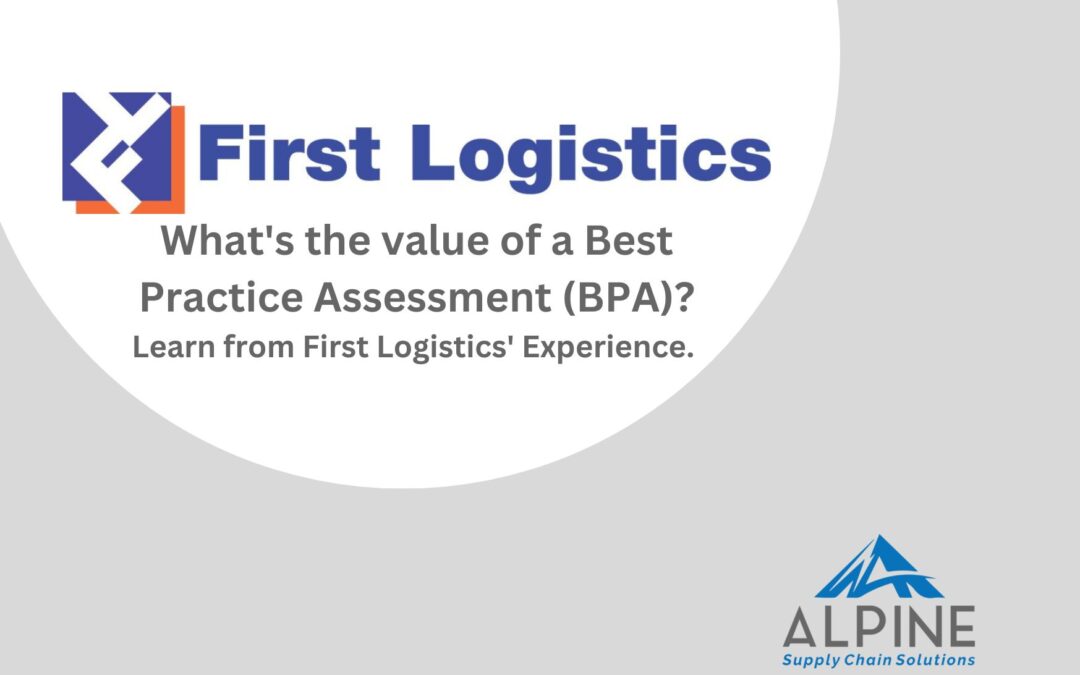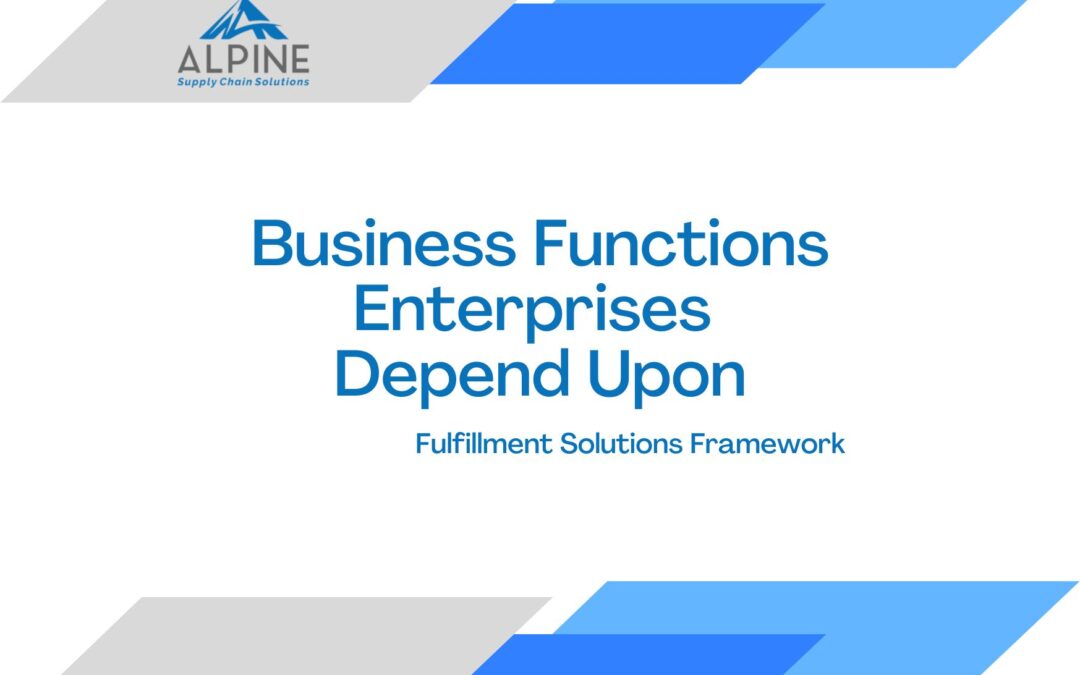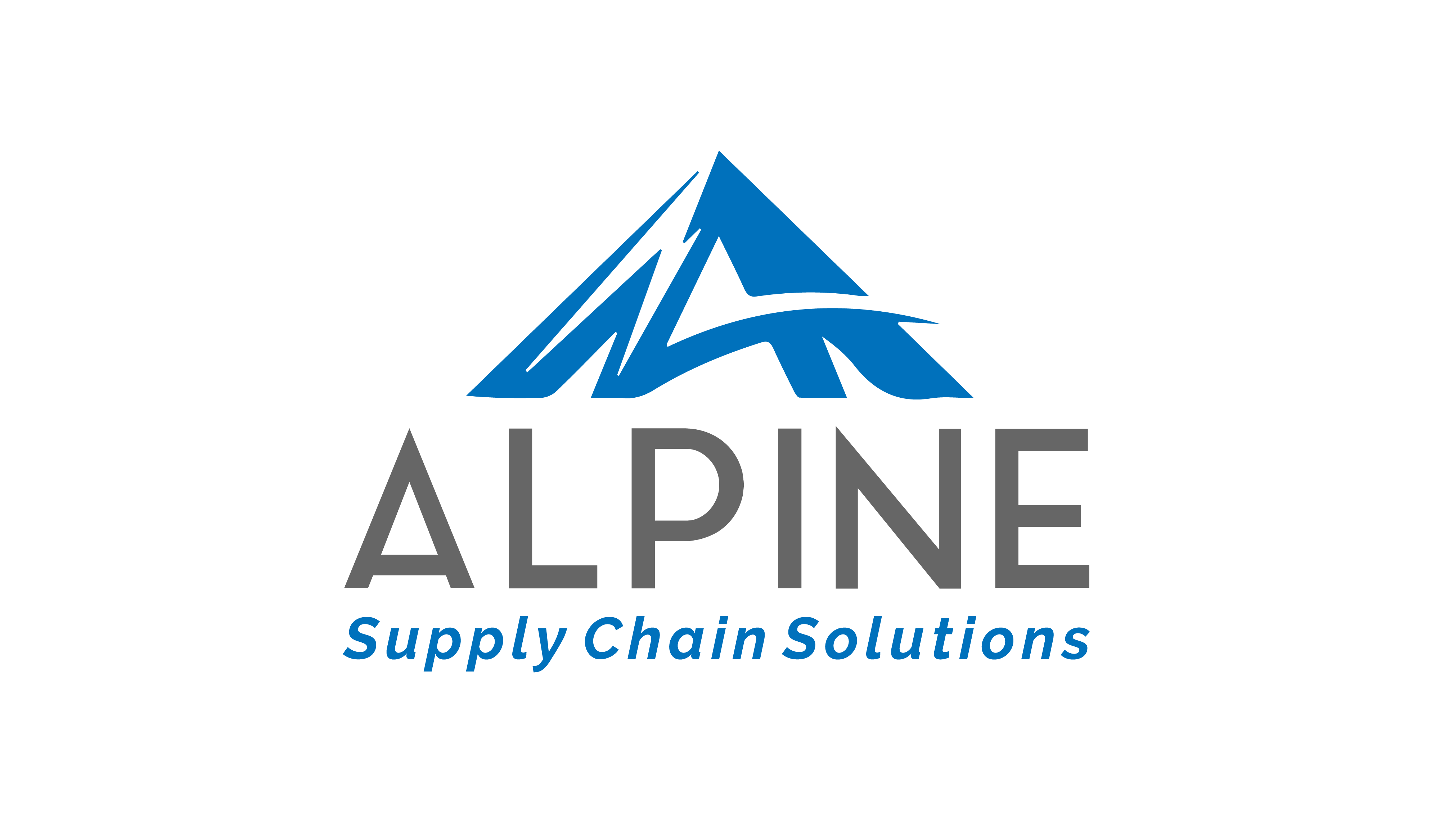
by Noelle Abarelli | Dec 21, 2022 | Blog
When transportation and logistics leader First Logistics’ growth took off, so did their need for a more robust Warehouse Management System (WMS). Their homegrown Inventory Control System wasn’t built to handle their increasing order volumes and system limitations were hampering associate productivity and impeding a sustainable Flow-of-Goods operating model. Plus, the homegrown system was dependent on outsourced partners, which introduced a high level of risk. First Logistics wanted to ensure they invested in the right WMS for their business, so the supply chain leadership team decided to embark on Best Practice Assessment (BPA) to gain a better understanding of their requirements and build a solid case to cost to justify their investment. They engaged Alpine Supply Chain Solutions to lead the exercise.
According to Alpine’s Managing Principal, Michael Wohlwend, “A BPA is a great exercise to help organizations uncover opportunities for improvement while benchmarking their operations against competitive, best-in-class operations. They take just a few weeks and are a great fit for companies seeking to identify supply chain improvements, define requirements, estimate costs, and quantify ROI.”
How does a Best Practice Assessment work?
A BPA will vary by client and objective, but a standard engagement ensures that all business processes and areas of operation are fully reviewed and assessed. By diving deep into the details, a BPA can uncover capital and non-capital improvements across all operational areas including inventory, space, equipment, labor, and systems.
A standard engagement is a four-week process and will look as follows:
Week 1: Data Collection
Our data-driven methodology leverages a deep dive into metrics in every area of your operations including procurement and receiving; putaway; restocking and replenishment; order processing and selection; shipping, staging, loading, VAS; and more.
Week 2: Data Validation
We validate initial data findings during an onsite visit and cross-reference our findings against Best Practice metrics from market leaders such as WERC, ROFDA, and ISO.
Week 3: Qualification
We share initial findings to prioritize the initiatives that streamline business processes to increase operational performance, improve customer service, and reduce cost.
Week 4: Final Results
We create and deliver a plan of actionable improvement recommendations and associated ROI.
What’s the value of a Best Practice Assessment?
The value of a BPA varies by the initial objective of the exercise. For First Logistics, a BPA enabled the supply chain leadership team to confidently respond when Executive Leadership questioned what a WMS would cost, how long an implementation would take, and when they could expect to see benefits. The project was approved as was the cost to add additional resources to implement the WMS as the team was able to clearly identify what resources were available and where there were gaps.
Why the time is right for a Best Practice Assessment
Over the past few years, supply chain leaders have faced more complex, changing conditions than ever before. Enterprises of all shapes and sizes are seeking to shake up their supply chain strategies to become more resilient, collaborative, and networked with customers, suppliers, and other stakeholders. A BPA offers a great method for understanding which supply chain Best Practices will significantly improve product quality, customer service levels, market share, and return on assets, and as a result, your company’s overall performance. Reach out if you’re interested in learning more.

by Noelle Abarelli | Nov 23, 2022 | Blog
Executives tasked with delivering continuous improvement within the enterprise’s fulfillment and supply chain operations are always seeking the best way to chart a path to success. They are on the hunt for the next “Big Idea” that will deliver this year’s victory. But, this constant quest is constrained by many factors:
- A clear understanding of the strategic direction of the corporation
- A definitive understanding of the current state of the enterprise’s fulfillment operations
- An understanding of how their operations stack up against their competitors’ operations
Executives must also overlay emerging best business practices for fulfillment operations and enabling technology solutions — and then decide which ones are worth adopting in their organization. This isn’t an easy task, but fortunately, there is a framework that can help.
Alpine’s Fulfillment Solutions Framework is a tool that can help supply chain executives identify that next “Big Idea” and chart the path to success. It is a presentation of functional areas for which advanced supply chain process approaches and technology systems have been developed, implemented, and proven to deliver business value in multiple enterprises and industries.
Download the framework today to learn more about the functional areas that have the greatest impact on improving, or creating, the high-performance supply chains and fulfillment operations that are at the heart of strong corporate performance. You can use it to:
- Measure the completeness of your fulfillment practices and supporting technologies
- Determine which proven solutions exist that you can apply to your situation
- Understand the impact these solutions can have on your fulfillment operation’s performance
This framework is designed to provide a broad model for manufacturing and distribution organizations that can be easily adjusted to each organization’s specific business. Download the White Paper today, and get ready for a great 2023. If you’re looking for other ways to get the most out of your supply chain, then look no further, just give us a call.

by Noelle Abarelli | Nov 14, 2022 | Alpine News Blog
All of us at Alpine Supply Chain Solutions are dedicated to improving people’s lives, both inside and outside of the warehouse. While our main focus is on bringing efficiencies to supply chain operations by leveraging data to maximize space, equipment, and labor, we’re just as committed to helping our community at large. That is why it was a true honor to hop on board as a sponsor for MONAT Gratitude’s fifth annual Feast with Gratitude event on Saturday, November 5, 2022.
In partnership with Farm Share and Miami Diaper Bank, this event successfully distributed approximately 80,000 pounds of food and more than $250,000 in essential items, including diapers and baby wipes to families with young children. MONAT Gratitude was founded as a philanthropic entity of MONAT Global to help families and children around the world, and they’re doing just that.
MONAT Gratitude is committed to providing educational resources in the areas of art, music, entrepreneurship, and athletics in communities around the world. They work mainly by filling in the gaps left by the various cuts in education, especially for children in underserved areas, because:
- These activities help children with the development of motor skills, language skills, social skills, decision-making, risk-taking and inventiveness. They provide challenges for learners at all levels.
- This programming reduces violence and school dropouts, while also increasing graduation rates and the likelihood that young people will pursue additional educational opportunities after high school.
- These activities offer opportunities for students to learn the values of teamwork, individual and group responsibility, physical strength and endurance, competition, diversity, and a sense of culture and community.
We’re grateful to have supported our client in this effort to give back to their local community. To learn more about MONAT Gratitude, or to make a donation, visit the MONAT Gratitude website.

by Noelle Abarelli | Nov 8, 2022 | Alpine News Blog
When MJ Holding, the largest North American distributor of trading cards and novelties to retail stores, found they were conducting business out of five buildings, they knew it was time to make a change to their warehouse operations. Conveyor Solutions, Inc. (CSI) was brought in to assist with consolidating operations into a new 360,000-square-foot facility. And, CSI tapped Alpine Supply Chain Solutions to help define the facility’s storage methodology and workflows.
With a footprint that spans 8,000 retail stores in the United States and Canada, including chains like Target and Walmart, MJ Holding releases around 550 new products each year. With such a comprehensive inventory, Alpine started with a thorough analysis of its data. All retail and e-commerce sales were analyzed and storage type analysis (STA) was performed to help design the best layout possible for picking operations. A sensitivity analysis of the top 5% of inventory items was also completed to uncover additional efficiencies for the operation.
The data found that 35% of MJ Holding’s inventory moved too slowly, and 5% of it moved too quickly for the planned case flow picking setup, which could lead to significant replenishment issues down the line. With this information in hand, Alpine developed a three-level pick module separated into 12 zones, ensuring each employee is able to get a full day’s worth of work completed.
The new layout led to:
- The ability to pick the equivalent order volume in 57% of the original time
- A 43% reduction in labor for peak one-day order file
- The ability to handle 30,000 orders a day, instead of 12,000
Alpine’s data analysis spotted a trend in MJ Holding’s growing e-commerce activity, which helped them move forward with implementing an e-commerce platform to foster their interaction directly with consumers. The best part? The platform went live in the fall of 2019, so when the pandemic hit in March 2020, they were well-positioned to meet growing demand without batting an eye.
For the full story, check out Inbound Logistics’ feature. If you’re looking for assistance in your warehouse, reach out! We’re here to ensure you get the most out of your supply chain investments.

by Noelle Abarelli | Nov 3, 2022 | Alpine News Blog
2020 was a year marked by fear, uncertainty, and stress, but it was also one that led to innovation for many, like Monat Global. A multinational distributor of premium beauty products, Monat Global had already been planning to modernize its storage and fulfillment processes to meet growing demand, and the pandemic led them to hit the accelerator. For a look into the entire process, check out DC Velocity’s feature, or get the highlights below.
Storage
Back in 2019, Monat Global teamed up with Alpine Supply Chain Solutions to work on their expansion plans. Monat was outgrowing its 70,000-square-foot facility in suburban Miami, FL and with Alpine’s help, they were able to secure a 159,000-square-foot facility in Doral, FL – close to its existing location. This new facility would feature high-density storage, incorporating drive-in-, select, and push-back racking to maximize space and improve overall productivity. Alpine’s storage analysis and facility design/layout streamlined the flow of pallets into and out of the facility. Matt Warner, Monat’s chief operating officer, explained this meant Monat went from 5,000 pallet positions with its previous storage setup to more than 9,000 pallet positions.
Picking
Up until this project, Monat was using largely manual processes when it came to picking which was impeding productivity. By installing conveyors, sorters, a pick-to-light system, mobile computing, bar-code scanning, and SAP’s Extended Warehouse Management (EWM) WMS, they were able to achieve a 48% improvement in lines filled per hour. Overall production through the facility per hour improved by 65%.
Automation
Now that Monat has addressed space constraints and manual processes in FL, they can take those learnings for building a new distribution hub in Dallas, TX. The plan is to build a similar facility with maximized storage space and a variety of automation in place, with an eye on adding new automation technologies as they become available. Monat will also implement a learning management system for employee training and education, a labor management system, and an automated dock door scheduling system. This is projected to save Monat $3 million.
Alpine’s Managing Principal, Michael Wohlwend says it all comes back to strategic planning, adding that “world-class preparation leads to flawless execution.” For the full story, check out DC Velocity’s feature. If you’re looking for assistance in your warehouse, reach out! We’re here to ensure you get the most out of your supply chain investments.






